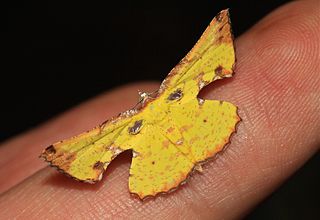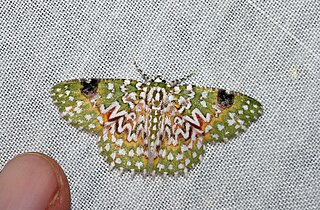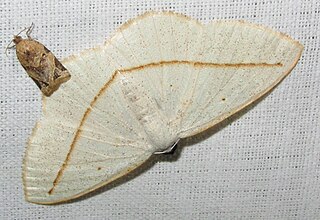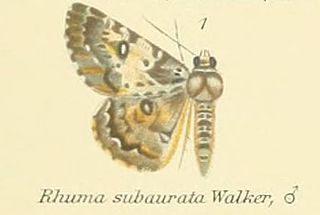
Gellonia dejectaria, the brown evening moth, is a moth in the family Geometridae. The species was first described by Francis Walker in 1860. It is endemic to New Zealand.

Cleora is a genus of moths in the family Geometridae. The genus was erected by John Curtis in 1825.

Corymica is a genus of moths in the family Geometridae described by Francis Walker in 1860.

Didymoctenia is a monotypic moth genus in the family Geometridae and subfamily Ennominae which was described by Warren in 1901. Its only species, Didymoctenia exsuperata, the thick-lined bark moth, was first described by Francis Walker in 1860. It is found in Australia.

Eucyclodes gavissima, the Oriental orange banded green geometer moth, is a species of moth of the family Geometridae described by Francis Walker in 1861. It is found in the Indian subregion, Sri Lanka, Bhutan, western China, Taiwan, Sumatra and Borneo.

Nisista serrata, the serrated crest-moth, is a species of moth of the family Geometridae first described by Francis Walker in 1857. It is found in Australia, including Tasmania, Victoria and South Australia.

Fascellina chromataria is a moth in the family Geometridae described by Francis Walker in 1860. It is found in Korea, Japan, Taiwan, China, India, Bhutan and Sri Lanka.

Lomographa inamata is a moth in the family Geometridae first described by Francis Walker in 1860. It is found in Sri Lanka, Japan, China, India and Taiwan.
Scopula aspilataria is a moth of the family Geometridae. It was described by Francis Walker in 1861. It is found in Sri Lanka.
Scopula emissaria is a moth of the family Geometridae. It was described by Francis Walker in 1861. It is found in India, Sri Lanka, Myanmar, Vietnam, China, Korea, Japan, the Philippines, Sumatra, Java, Wallacea and Australia.

Rhuma subaurata is a moth of the family Geometridae first described by Francis Walker in 1860. It is found in the Australian states of Queensland and New South Wales.

Collix ghosha is a moth in the family Geometridae. It was described by Francis Walker in 1862. It is found in the Indo-Australian tropics, from the Indian subregion, Sri Lanka to Queensland, Japan and New Caledonia.
Glaucoclystis polyclealis is a moth in the family Geometridae described by Francis Walker in 1859. It is found in Sri Lanka and on Borneo, Java and Bali.
Carbia pulchrilinea is a moth in the family Geometridae. The species was first described by Francis Walker in 1866. It is found in the Indian subregion, Sri Lanka and New Guinea, as well as on Borneo, the Mentawai Islands and the Bismarck Archipelago. The species is found from lowlands to the upper montane forest zone.

Hyposidra talaca, the black looper or black inch worm, is a moth of the family Geometridae. The species was first described by Francis Walker in 1860. It is found from India to Indochina, Sundaland, Sulawesi, the Philippines, Sri Lanka, the Solomon Islands, Thailand, Taiwan, New Guinea and Australia, where it has been recorded from Queensland. It is a major defoliating pest in tea plantations.
Phalacra vidhisara is a moth in the family Drepanidae. It was described by Francis Walker in 1860. It is found in Sri Lanka and India.

Cleora scriptaria, the kawakawa looper moth, is a moth in the family Geometridae found only in New Zealand.

Calletaera postvittata is a moth of the family Geometridae first described by Francis Walker in 1861. It is found in the Indian sub-region, Sri Lanka, Taiwan, and Sundaland.

Cleora alienaria is a moth of the family Geometridae first described by Francis Walker in 1860. It is found in Sri Lanka, the Indian subregion to the Andaman Islands, Thailand, Sundaland, Taiwan, and Lesser Sundas as far east as Timor and Christmas Island.
Semiothisa ozararia, is a moth of the family Geometridae first described by Francis Walker in 1860. It is found in the Indian subregion, Sri Lanka, Taiwan, Borneo, Sumatra and Java.






















